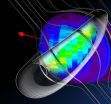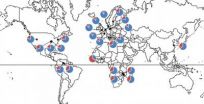(Press-News.org) Understanding the region of interstellar space through which the solar system travels is no easy task. Interstellar space begins beyond the heliosphere, the bubble of charged particles surrounding the sun that reaches far beyond the outer planets. Voyager 1 has crossed into this space, but it's difficult to gain a complete global picture from measurements in only one direction.
Spacecraft data in the past five years from near Earth and cosmic ray observations have painted a better picture of the magnetic system that surrounds us, while at the same time raising new questions. Scientists are challenging our current understanding in a new study that combines observations of massively energetic cosmic ray particles streaming in from elsewhere in the Milky Way along with observations from NASA's Interstellar Boundary Explorer, or IBEX.
The data sets show a magnetic field that is nearly perpendicular to the motion of our solar system through the galaxy. In addition to shedding light on our cosmic neighborhood, the results offer an explanation for a decades-old mystery on why we measure more incoming high-energy cosmic rays on one side of the sun than on the other. The research appears in the Feb. 13, 2014, issue of Science Express.
"It's a fascinating time," said Nathan Schwadron, of the University of New Hampshire in Durham and first author on the paper. "Fifty years ago, we were making the first measurements of the solar wind and understanding the nature of what was just beyond near-Earth space. Now, a whole new realm of science is opening up as we try to understand the physics all the way outside the heliosphere."
The heliosphere is formed as the constant stream of particles from the sun's solar wind flows outward in all directions until it slows down to balance the pressure from the interstellar wind. The only information gathered directly from the heart of this complex boundary region is from NASA's Voyager mission. Voyager 1 entered the boundary region in 2004, passing beyond the termination shock where the solar wind abruptly slows down. Voyager 1 crossed into interstellar space in 2012.
IBEX, which orbits Earth, studies these regions from afar. The spacecraft detects energetic neutral atoms that form from interactions at the heliosphere's boundaries – an area that holds fascinating clues to what lies beyond. These interactions are dominated by electromagnetic forces. The incoming particles from the galaxy are made up of negatively-charged electrons, positively-charged atoms called ions, neutral particles and dust. Charged particles are forced to travel along the magnetic field lines that snake throughout space. Sometimes, a charged particle collides with a neutral atom at the outskirts of the heliosphere and captures an electron from the neutral atom. After stealing the electron, the charged particle becomes electrically neutral and speeds off in a straight line. Some of these fast neutral particles stream into the inner solar system and reach IBEX's detectors. Depending on the speed and direction of those neutral particles, scientists can determine information about the atoms and magnetic field lines involved in the original collision.
In 2009, IBEX scientists presented research showing an uneven distribution of neutral atoms. There was a ribbon along the heliospheric boundaries sending a preponderance of neutral atoms toward IBEX.
Researchers wondered if this shape might also relate to an unevenness seen in cosmic rays. On Earth, we measure more cosmic rays – particles that stream in from the rest of the galaxy at 99% the speed of light – coming in from near the tail side of the heliosphere than from the other side. Teasing out the source and paths of incoming cosmic rays isn't easy as the rays gyrate around magnetic field lines both inside and outside our heliosphere before colliding with other particles in Earth's atmosphere, giving a shower of secondary particles that, in turn, are what we detect. To complicate things further, the heliosphere is moving through the galaxy.
"At some level, it's like trying to determine the wind direction when you're riding a bike very quickly and the wind isn't particularly strong," said Eric Christian, the IBEX project scientist at NASA's Goddard Space Flight Center in Greenbelt, Md., and a co-author on the paper. "There's some effect from the wind, but it's small and hard to measure."
To see if the IBEX data related to the cosmic ray observations, Schwadron used IBEX data to build a computer model of what the interplanetary magnetic field would look like around the heliosphere. Without the heliosphere, the field lines would be straight and parallel.
"But the heliosphere is kind of like an egg sitting in the middle of all these magnetic field lines," said Schwadron. "The field lines have to distort themselves around that."
With this model in hand, he simulated how the heliosphere would affect the cosmic rays. He assumed that the rays came in to the heliosphere evenly from everywhere in space, but allowed them to be warped based on the local magnetic geometry. The simulations showed a non-uniform distribution of cosmic ray particles that jibed well with the unevenness seen in observations.
"The analysis of this important paper strongly correlates with the theoretical view of the heliosphere from the numerical model developed by our team, which uses IBEX observations to derive the interstellar magnetic field direction," said Nick Pogorelov, a space scientist at the University of Alabama in Huntsville, who works with IBEX data. "It shows that the heliopause that separates solar and interstellar plasmas is very long, maybe 2 trillion miles in the downwind direction, and therefore may affect the transport of high-energy cosmic rays toward the solar system."
Unfortunately, this doesn't prove that the heliosphere and the interstellar magnetic field are exclusively responsible for the cosmic ray mystery. However, this research shows that the magnetic configuration of our neighborhood does offer a potential answer.
Moreover, the agreement between what's seen in the cosmic ray data and by IBEX provides outside confirmation of IBEX's results of what the magnetic fields outside our heliosphere look like. That's an interesting piece of the puzzle, when compared with Voyager 1's measurements, because the Voyager 1 data provide a different direction for the magnetic fields just outside our heliosphere.
This doesn't mean that one set of data is wrong and one is right, says Schwadron. Voyager 1 is taking measurements directly, gathering data at a specific time and place; IBEX gathers information averaged over great distances, so, there is room for discrepancy. Indeed, that discrepancy can be used as a clue. Understand why there's a difference between the two measurements and we gain additional information. More IBEX observations and more Voyager observations will keep coming in. As with all research, more data will help unravel the picture and soon we will learn even more about how we fit into the rest of the universe.
INFORMATION:
For more information about IBEX, visit:
http://www.nasa.gov/ibex
NASA's IBEX helps paint picture of the magnetic system beyond the solar wind
2014-02-14
ELSE PRESS RELEASES FROM THIS DATE:
Impaired recovery from inflammation linked to Alzheimer's
2014-02-14
New research from Karolinska Institutet in Sweden shows that the final stage of the normal inflammatory process may be disrupted in patients with Alzheimer's disease. A study published in the journal Alzheimer's & Dementia shows that levels in the brain and cerebrospinal fluid of the molecules necessary for tissue recovery through the clearance of harmful inflammatory substances are lower than normal in patients with Alzheimer's disease. The study also showed association between the lower levels of these molecules with impaired memory function.
Alzheimer's disease is ...
Social norms strongly influence vaccination decisions and the spread of disease
2014-02-14
Our response to societal pressures about vaccination has a direct effect on the spread of pediatric infectious diseases in areas where inoculation is not mandatory, says new research published this week in Proceedings of the Royal Society B.
By incorporating social norms into predictive mathematical modelling, a research team from the University of Guelph and the University of Waterloo found that they can foresee the observed patterns of population behaviour and disease spread during vaccine scares—times when anti-vaccine sentiment is strong.
"If vaccination is not ...
New insight into protein misfolding in neurodegenerative disorders
2014-02-14
Research by the University of Southampton has provided new insight into the consequence of accumulated 'misfolded proteins' in neurodegenerative disorders, such as Prion and Alzheimer's disease.
Prion and Alzheimer's disease are protein misfolding brain diseases, where genetic mutations, or more commonly, interactions between an individual's genetics and environmental influences cause functional proteins in neurons to become misfolded or misrouted. In these diseases, there is a progressive death of nerve cells in specific brain regions, which is associated with the increasing ...
Geographical passwords worth their salt
2014-02-14
It's much easier to remember a place you have visited than a long, complicated password, which is why computer scientist Ziyad Al-Salloum of ZSS-Research in Ras Al Khaimah, UAE, is developing a system he calls geographical passwords.
Writing in a freely available "open access" research paper in the International Journal of Security and Networks, Al-Salloum emphasizes how increasingly complicated our online lives are becoming with more and more accounts requiring more and more passwords. Moreover, he adds that even strong, but conventional passwords are a security risk ...
Antimicrobial preservation strategies to prevent food contamination
2014-02-14
New Rochelle, NY, February 13, 2014—Food spoiling and poisoning caused by microbial contamination can cause major health, social, and economic problems. The broad scope of antimicrobial approaches to kill or prevent the growth of microorganisms in foods and beverages, including a variety of natural and artificial preservative strategies, are described in a comprehensive Review article in Industrial Biotechnology, a peer-reviewed journal from Mary Ann Liebert, Inc., publishers. The article is available on the Industrial Biotechnology website.
In the Review "Ingredient ...
New depression treatments reported
2014-02-14
MAYWOOD, IL – New insights into the physiological causes of depression are leading to treatments beyond common antidepressants such as Prozac and Zoloft, researchers are reporting in the in the journal Current Psychiatry.
Depression treatments on the horizon include new medications, electrical and magnetic stimulation of the brain and long-term cognitive behavioral therapy for stress management.
Authors are Murali Rao, MD, and Julie M. Alderson, DO. Rao is professor and chair of the Department of Psychiatry and Behavioral Neurosciences at Loyola University Chicago ...
Geographic variation of human gut microbes tied to obesity
2014-02-14
People living in cold, northern latitudes have bacteria in their guts that may predispose them to obesity, according to a new study by researchers at the University of California, Berkeley, and the University of Arizona, Tucson.
The researchers' analysis of the gut microbes of more than a thousand people from around the world showed that those living in northern latitudes had more gut bacteria that have been linked to obesity than did people living farther south.
The meta-analysis of six earlier studies by UC Berkeley graduate student Taichi Suzuki and evolutionary ...
What do women want? It depends on the time of the month
2014-02-14
If she loves you and then she loves you not, don't blame the petals of that daisy. Blame evolution.
UCLA researchers analyzed dozens of published and unpublished studies on how women's preferences for mates change throughout the menstrual cycle. Their findings suggest that ovulating women have evolved to prefer mates who display sexy traits – such as a masculine body type and facial features, dominant behavior and certain scents – but not traits typically desired in long-term mates.
So, desires for those masculine characteristics, which are thought to have been ...
Another reason to not mix work and family: Money makes parenting less meaningful
2014-02-14
Austin – February 14, 2014 - Money and parenting don't mix. That's according to new research that suggests that merely thinking about money diminishes the meaning people derive from parenting. The study is one among a growing number that identifies when, why, and how parenthood is associated with happiness or misery.
"The relationship between parenthood and well-being is not one and the same for all parents," says Kostadin Kushlev of the University of British Columbia. While this may seems like an obvious claim, social scientists until now have yet to identify the psychological ...
In-hospital formula use deters breastfeeding
2014-02-14
(SACRAMENTO, Calif.) — When mothers feed their newborns formula in the hospital, they are less likely to fully breastfeed their babies in the second month of life and more likely to quit breastfeeding early, even if they had hoped to breastfeed longer, UC Davis researchers have found.
"We are a step closer to showing that giving formula in the hospital can cause problems by reducing how much women breastfeed later," says Caroline Chantry, lead author and professor of clinical pediatrics at UC Davis Medical Center. "Despite being highly motivated to breastfeed their babies, ...





